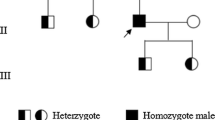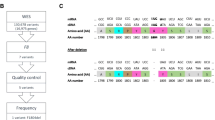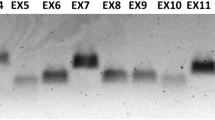Summary
The 3′ portion of the coagulation factor VII gene, containing the activation and serine protease domains, was investigated in four subjects with factor VII deficiency by temperature gradient gel electrophoresis and sequencing of polymerase chain reaction (PCR) products. Molecules displaying an altered melting behaviour were detected in three subjects, and direct sequencing showed two mutations. A G-to-T transversion causing a missense mutation, Cys-310 to Phe, suppresses a disulphide bond conserved in the catalytic domain of all serine proteases. This mutation, which in the homozygous form causes a severe reduction in protease activity (4%), was found in two patients from different Italian regions. A G-to-A transition, which gives rise to a missense mutation, Arg-304 to Gln, and is associated with the factor VII Padua variant, was found in the heterozygous form in a subject also affected by von Willebrand disease. Two polymorphic alleles, which differ in one repeat monomer element, were precisely mapped in a region spanning the exon-intron 7 border of the factor VII gene and studied in families with factor VII or X deficiency.
Similar content being viewed by others
References
Alexander B, Goldstein R, Landwehr G, Cook CD (1951) Congenital SPCA deficiency. A hitherto unrecognized coagulation defects with hemorrhage rectified by serum and serum fractions. J Clin Invest 30:237–246
Bernardi F, Marchetti G, Guerra S, Casonato A, Gemmati D, Patracchini P, Ballerini G, Conconi F (1990) A de novo and heterozygous gene deletion causing a variant of von Willebrand disease. Blood 75:677–683
Boyd CD, Weliky K, Toht-Fejel S, Deak SB, Christiano AM, Mackenzie JW, Sandell LJ, Tryggvason K, Magenis E (1986) The single copy gene coding for human alpha-1(IV) procollagen is located at the terminal end of the long arm of chromosome 13. Hum Genet 74:121–125
Broze GJ Jr, Majerus PW (1980) Purification and properties of human coagulation factor VII. J Biol Chem 255:1242–1247
Chaing SH, High KA (1991) Severe FVII deficiency associated with two missense mutations in the FVII gene. Abstract of XIIth Congress of the International Society on Thrombosis and Haemostasis, Amsterdam, The Netherlands, 30 June–6 July 1991. Thromb Haemost 65:1262
Fischer SG, Lerman LS (1983) DNA fragments differing by single base-pair substitutions are separated in denaturing gradient gels: correspondence with the melting theory. Proc Natl Acad Sci USA 80:1579–1583
Gilgenkrantz S, Briquel ME, Andre E, Alexandre P, Jalbert P, Le Marec B, Pouzol P, Pommereuil M (1986) Structural genes of coagulation factors VII and X are located on 13q34. Ann Genet 29:32–35
Girolami A, Coser P, Brunetti A, Prinoth O (1975) Classical factor X deficiency. Acta Haematol 53:118–127
Girolami A, Falezza G, Patrassi G, Stenico M, Vettore L (1977) Factor VII Verona coagulation disorder: double heterozygosis with an abnormal factor VII and heterozygous factor VII deficiency. Blood 50:603–610
Girolami A, Fabris F, Dal Bo Zanon R, Ghiotto G, Burul A (1978) Factor VII Padua: a congenital coagulation disorder due to abnormal FVII with a peculiar activation pattern. J Lab Clin Med 91:387–395
Girolami A, Cottarozzi G, Dal Bo Zanon R, Cella G, Toffanin F (1979) Factor VII Padua 2: another factor VII abnormality with defective ox brain thromboplastin activation and a complex hereditary pattern. Blood 54:46–53
Girolami A, Dal Bo Zanon R, Zanella F, Procidano M, Ruffato G (1982) Factor VII Padua defect: the heterozygote population. Acta Haematol 68:34–38
Green F, Kelleher C, Wilkes H, Temple A, Meade T, Humphries S (1991) A common polymorphism of the factor VII gene determines coagulation factor VII levels in healthy individuals. Abstract of XIIth Congress of the International Society on Thrombosis and Haemostasis, Amsterdam, The Netherlands, 30 June–6 July 1991. Thromb Haemost 65:667
Green PM, Bentley DR, Mibashan RS, Nilsson IM, Giannelli F (1989) Molecular pathology of haemophilia B. EMBO J 8:1067–1072
Grouchy J de, Dautzenberg MD, Turleau C, Beguin S, Chavin-Colin F (1984) Regional mapping of clotting actors VII and X to 13q34. Expression of factor VII through chromosome 8. Hum Genet 66:230–233
Hagen FS, Gray CL, O'Hara P, Grant FJ, Saari GC, Woobury RG, Hart CE, Insley M, Kisiel W, Kurachi K, Davie EW (1986) Characterization of a cDNA coding for human factor VII. Proc Natl Acad Sci USA 83:2412–2416
Hedner U, Davie EW (1989) Introduction to hemostasis and the vitamin K-dependent coagulation factors. In: Scriver CR, Beaudet AL, Sly WS, Valle D (eds) The metabolic basis of inherited disease, 6th edn. McGraw-Hill, New York, pp 2107–2127
Hedner U, Kisiel W (1983) Use of human factor VIIa in the treatment of two hemophilia A patients with high titer inhibitors. J Clin Invest 71:1836–1841
Innis MA, Myambo KB, Gelfand DH, Brow MAD (1988) DNA sequencing with Thermus aquaticus DNA polymerase and direct sequencing of polymerase chain reaction-amplified DNA. Proc Natl Acad Sci USA 85:9436–9440
James HL, Girolami A, Fair DS (1991) Molecular defect in coagulation factor Xfriuli results from a substitution of serine for proline at position 343. Blood 77:317–323
James HL, Kumar A, Girolami A, Hubbard JG, Fair DS (1991a) Variant coagulation factors X and VII with point mutations in a highly conserved motif in the substrate binding pocket. Comparative molecular modeling. Abstract of XIIth Congress of the International Society on Thrombosis and Haemostasis, Amsterdam, The Netherlands, 30 June–6 July 1991. Thromb Haemost 65:937
Killen PD, Francomano CA, Yamada Y, Modi WS, O'Brien SJ (1987) Partical structure of the human alpha-2(IV) collagen chain and chromosomal localization of the gene (COL4A2). Hum Genet 77:318–324
Kisiel W, Fujikawa K, Davie EW (1977) Activation of bovine factor VII (proconvertin) by factor XIIa (activated Hageman factor). Biochemistry 16:4189–4194
Koeberl DD, Bottema CD, Ketterling R, Bridge PJ, Lillicrap DP, Sommer SS (1990) Mutations causing hemophilia B: direct estimate of the underlying rates of spontaneous germ-line transitions, transversion, and deletions in a human gene. Am J Hum Genet 47:202–217
Kumar A, Blumenthal DK, Fair DS (1991) Identification of molecular sites on factor VII which mediate its assembly and function in the extrinsic pathway activation complex. J Biol Chem 266:915–921
Leytus SP, Foster DC, Kurachi K, Davie EW (1986) Gene for human factor X: a blood coagulation factor whose gene organisation is essentially identical with that of factor IX and protein C. Biochemistry 25:5098–5102
Long GL (1986) Structure and evolution of the human genes encoding protein C and coagulation factors VII, IX, and X. Cold Spring Harbor Symp Quant Biol 60:525–529
Marchetti G, Gemmati D, Patracchini P, Pinotti P, Bernardi F (1991) PCR detection of a repeat polymorphism within the F7 gene. Nucleic Acids Res 19:4570
Miller CH, Hilgartner MW, Harris MB, Bussel JB, Haledort LM (1986) Concurrence of von Willebrand disease and hemophilia A: implications for carrier detection and prevalence. Am J Med Genet 24:83–94
Myers RM, Lumelsky N, Lerman LS, Maniatis T (1985) Detection of single base substitutions in total genomic DNA. Nature 313:495–498
O'Brien DP, Gale K, Anderson JS, Mcvey JH, Meade T, Miller G, Tuddenham EGD (1991) FVII-304 Gln: a dysfunctional FVII molecule with reduced affinity for tissue factor. Abstract of XIIth Congress of the International Society on Thrombosis and Haemostasis, Amsterdam, The Netherlands, 30 June–6 July 1991. Thromb Haemost 65:769
O'Hara PJ, Grant FJ (1988) The human factor VII gene is polymorphic due to variation in repeat copy number in a minisatellite. Gene 66:147–158
O'Hara PJ, Grant FJ, Haldeman BA, Gray CL, Insley MY, Hagen FS, Murray MJ (1987) Nucleotide sequence of the gene coding for human factor VII, a vitamin K-dependent protein participating in blood coagulation. Proc Natl Acad Sci USA 84:5158–5162
Pfeiffer RA, Ott R, Gilgenkrantz S, Alexandre P (1982) Efficiency of coagulation factors VII and X associated with deletion of a chromosome 13 (q34). Hum Genet 62:358–360
Radcliffe R, Nemerson Y (1976) Mechanism of activation of bovine factor VII. Products of cleavage by factor X. J Biol Chem 251:4797–4802
Rao LVM, Rapaport SI (1990) Factor VIIa-catalyzed activation of factor X independent of tissue factor: its possible significance for control of hemophilic bleeding by infused factor VIIa. Blood 75:1069–1073
Reiss J, Cooper DN, Bal J, Slomsky R, Cutting GR, Krawczak M (1991) Discrimination between recurrent mutation and identity by descent: application to point mutations in exon 11 of the cystic fibrosis (CFTR) gene. Hum Genet 87:457–461
Rodeghiero F, Castaman G, Dini E (1987) Epidemiological investigation of the prevalence of von Willebrand disease. Blood 69:454–459
Saiki RK, Scharf S, Faloona F, Mullis KB, Horn GT, Erlich HA, Arnheim N (1985) Enzymatic amplification of beta-globin genomic sequences and restriction site analysis for diagnosis of sickle cell anemia. Science 230:1350–1354
Sanger F, Nicklen S, Coulson AR (1977) DNA sequencing with chain-terminating inhibitors. Proc Natl Acad Sci USA 74:5463–5467
Seligsohn U, Osterud B, Brown SF, Griffin JH, Rapaport SI (1979) Activation of human factor VII in plasma and in purified systems: Roles of activated factor IX, kallikrein, and activated factor XII. J Clin Invest 64:1056–1065
Thim L, Bjoern S, Christensen M, Nicolaisen EM, Lund-Hansen T, Pedersen AH, Edner Ulla (1988) Amino acid sequence and posttranslational modifications of human factor VIIa from plasma and transfected baby hamster kidney cells. Biochemistry 27:7785–7793
Triplett DA, Brandt JT, McGann Batard MA, Schaeffer Dixon JL, Fair DS (1985) Hereditary factor VII deficiency: heterogeneity defined by combined functional and immunochemical analysis. Blood 66:1284–1287
Valle D, Simell O (1983) The hyperornithinemias. In: Stanbury JB, Wyngaarden JB, Fredrickson DS, Goldstein JL, Brown MS (eds) Metabolic basis of inherited disease, 5th edn. McGraw-Hill, New York, pp 382–401
Author information
Authors and Affiliations
Rights and permissions
About this article
Cite this article
Marchetti, G., Patracchini, P., Gemmati, D. et al. Detection of two missense mutations and characterization of a repeat polymorphism in the factor VII gene (F7). Hum Genet 89, 497–502 (1992). https://doi.org/10.1007/BF00219173
Received:
Revised:
Issue Date:
DOI: https://doi.org/10.1007/BF00219173




